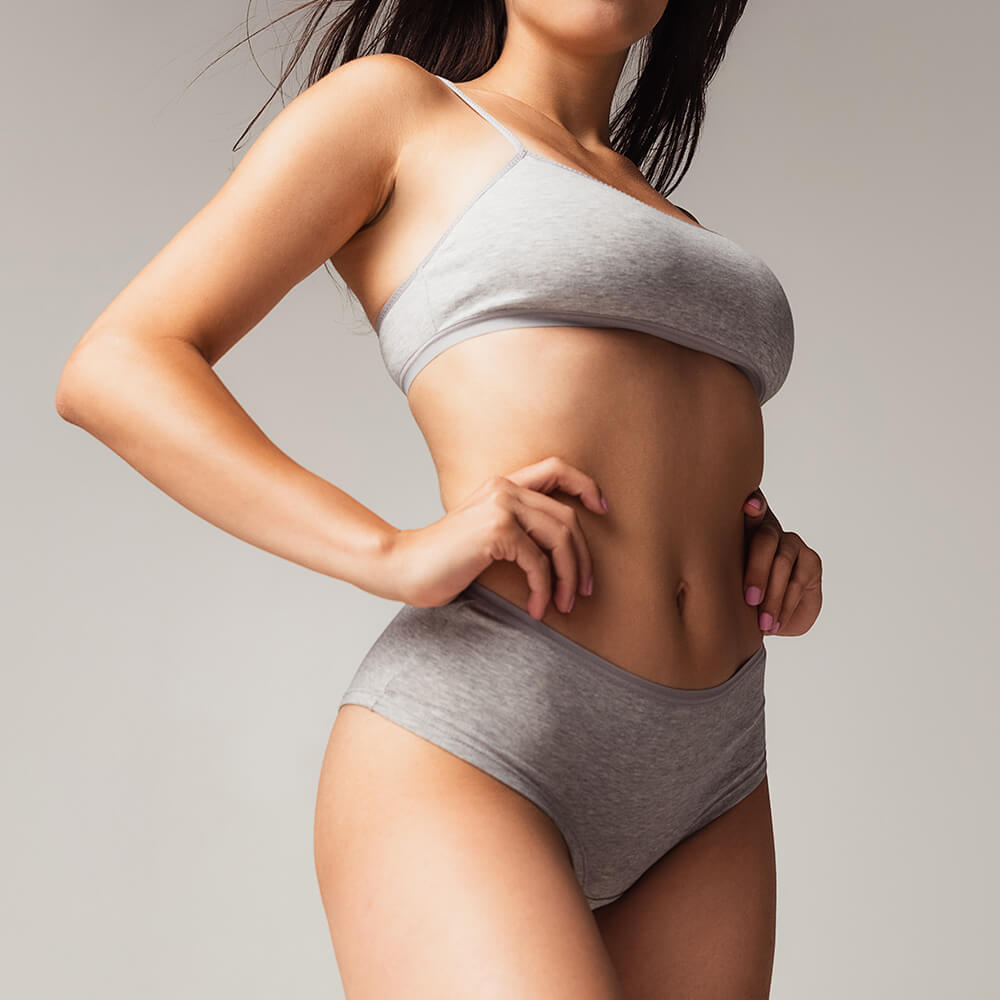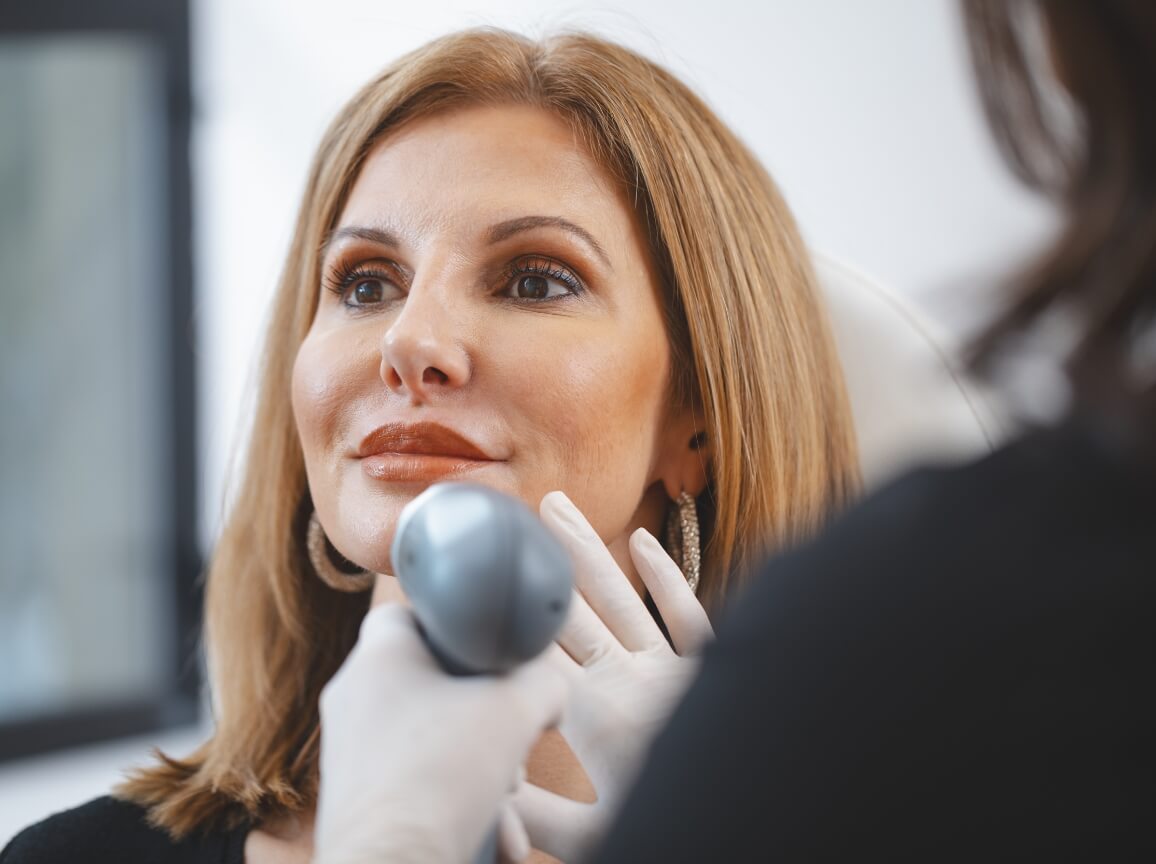Liposuction In Grass Valley, CA
 Model
Model
We all want to look our best, and there’s nothing like getting a helping hand in that effort. Aging, hormone changes, and weight fluctuations can all cause the body to retain fat more than it once did. Even with a healthy diet and exercise routine, stubborn pockets of fat can be very difficult to eliminate. If you are struggling to lose localized fat pockets, liposuction may be the ideal procedure for your body contouring goals.
 Model
Model
Dr. Lattyak and our team at the Élan Clinic are committed to providing natural-looking, safe liposuction results that are customized to the needs of our Grass Valley patients.
What Is Liposuction?
Liposuction is a procedure that can help sculpt the body by removing unwanted fat from specific areas, including:
- Abdomen
- Hips
- Buttocks
- Lower back and flanks
- Thighs
- Knees
- Upper arms
- Chin
- Cheeks
- Neck
- Bra bulge, armpit area
Although no type of liposuction is a substitute for a healthy diet and exercise, liposuction can remove stubborn areas of fat that don’t respond to traditional weight-loss methods.
Learn More About Dr. LattyakWhat Are the Benefits of Liposuction?
Liposuction has helped many people achieve a more slim, streamlined figure by removing localized pockets of fat. While liposuction is not a weight-loss solution, it can slim areas of the body and create a natural-looking contour. The benefits of liposuction include:
- Versatile applications
- Precise slimming and contouring
- Permanent fat removal
Am I a Candidate for Liposuction?
To be a good candidate for liposuction, you must have realistic expectations about what the procedure can do for you. It’s important to understand that liposuction can enhance your appearance and self-confidence, but it won’t necessarily change your looks to match your ideal or cause other people to treat you differently. Before you decide to have surgery, think carefully about your expectations and discuss them with Dr. Lattyak.
The best candidates for liposuction:
- Are close to their goal weight with stubborn pockets of fat in certain areas
- Are committed to achieving and maintaining a healthy body mass index (BMI) long term through healthy nutrition and regular exercise
- Have good skin elasticity
- Understand the risks of the procedure
- Have realistic expectations for results
- Are generally healthy nonsmokers
Your age is not a major consideration; however, older patients may have diminished skin elasticity and may not achieve the same results as younger patients with tighter skin.
Liposuction carries a greater risk for individuals with medical problems such as diabetes, significant heart or lung disease, poor blood circulation, or those who have recently had surgery near the area to be contoured. Be sure to discuss your health candidly with Dr. Lattyak during your consultation.
What Are My Liposuction Options?
Dr. Lattyak uses the tumescent liposuction technique for this procedure. Before beginning the procedure, Dr. Lattyak will inject a tumescent fluid into the treatment area. This fluid is made up of a combination of adrenaline, saline, and local anesthesia and helps prepare the treatment area, allowing for a more precise fat extraction.
Combining Your Liposuction With Other Procedures
One of the benefits of liposuction is its versatility; Patients can select a wide variety of treatment locations that can safely be slimmed via this procedure, and due to its precision, it can often be effectively paired with other body contouring procedures. Some popular procedures that are combined with liposuction include:
 Model
Model
Tummy Tuck
Patients seeking either a mini or full tummy tuck may benefit from contouring other adjacent areas of the body with liposuction, such as the hips, thighs, or flanks.
 Model
Model
Mommy Makeover
Women looking for a full-body transformation often choose to include liposuction with their Mommy Makeovers, as this procedure can help smooth and slim the body for a more cohesive result.
 Model
Model
Neck lift and Facelift
Liposuction of the anterior neck may be used as an adjunct to neck lift or facelift in patients with both excessive neck fat and significant skin laxity.
How Is Liposuction Performed?
Your Consultation
In your initial consultation, Dr. Lattyak will evaluate your health, determine where your fat deposits lie, and assess the condition of your skin. He will also explain the body contouring procedures that may be most appropriate for you. For example, if you believe you want liposuction in the abdominal area, you may learn that an abdominoplasty or tummy tuck may more effectively meet your goals.
Be frank in discussing your expectations with Dr. Lattyak. He will be equally frank with you, describing the procedure in detail and explaining its risks and limitations.
If you and Dr. Lattyak agree that this procedure is best for you, he will give you specific instructions on how to prepare for surgery, including guidelines on eating and drinking, smoking, and taking or avoiding vitamins, minerals, herbal supplements, and certain medications.
If you develop a cold or an infection of any kind, especially a skin infection, your surgery may have to be postponed. Though it is rarely necessary, Dr. Lattyak may recommend that you have blood drawn ahead of time in case it is needed during surgery. Also, while you are making preparations, be sure to arrange for someone to drive you home after the procedure and, if needed, to help you at home for a day or two.
If you are interested in liposuction and would like to see what option is best for you and your goals, call the Élan Clinic today at (530) 273-3400 to schedule a consultation with Dr. Lattyak.
The Liposuction Procedure
Liposuction is an outpatient procedure and can be performed under either local or general anesthesia. On the day of surgery, Dr. Lattyak will make marks around the treatment area to note where the incisions will be.
During the procedure, Dr. Lattyak will make small incisions around the treatment area. Through these incisions, he will insert a small, thin tube called a cannula, which is how the fat will be extracted. Dr. Lattyak will move the cannula back and forth to remove fat at a consistent, smooth rate to create a natural-looking contour. Once a satisfactory amount of fat is removed, he will carefully close the incisions.
 Model
Model
What Is Liposuction Recovery Like?
After surgery, you will likely experience some fluid drainage from the incisions. Occasionally, a small drainage tube may be inserted beneath the skin for a couple of days to prevent fluid build-up. To control swelling and to help your skin better fit its new contours, you may be fitted with a snug elastic garment, or compression garment, to wear over the treated area for a few weeks. Dr. Lattyak may also prescribe pain medication and/or antibiotics to prevent infection.
Don’t expect to look or feel great right after surgery. Even though the newer techniques are believed to reduce some post-operative discomforts, you may still experience some pain, burning, swelling, bleeding, and temporary numbness. Pain can be controlled with medications prescribed by Dr. Lattyak, though you may still feel stiff and sore for a few days.
Healing is a gradual process. Dr. Lattyak will probably tell you to start walking around as soon as possible to reduce swelling and to help prevent blood clots from forming in your legs.
You will begin to feel better after about a week or two, and you should be back at work within a few days following your surgery. The stitches typically dissolve on their own within the first couple of weeks.
Activity that is more strenuous should be avoided for about a month as your body continues to heal. Although most of the bruising and swelling usually disappears within three weeks, some swelling may remain for six months or more.
Dr. Lattyak will schedule follow-up visits to monitor your progress and to see if any additional procedures are needed. If you have any unusual symptoms between visits — for example, heavy bleeding or a sudden increase in pain — or any questions about what you can and can’t do, call Dr. Lattyak.
When Will I See My Liposuction Results?
You will see a noticeable difference in your body’s shape quite soon after surgery. However, improvement will become even more apparent after about four to six weeks, when most of the swelling has subsided. After about three months, any persistent mild swelling usually disappears, and the final contour will be visible.
If your expectations are realistic, you will probably be very pleased with the results of your surgery. You may find that you are more comfortable in a wide variety of clothes and more at ease with your body. Eating a healthy diet and getting regular exercise can help you maintain your new shape.
View before & after gallery



How Much Does Liposuction Cost in Grass Valley, CA?
Each liposuction procedure is unique to the needs and goals of the patient. The overall cost of liposuction in Grass Valley depends on the specifics of your surgical plan, which will detail the technique used, the size and location of the treatment area, the type of anesthesia used, and if there are any other combination procedures.
Once a surgical plan is created and agreed upon, our team will be happy to provide you with an accurate cost estimate.
Schedule A ConsultationWhat Are Alternatives to Liposuction?
Sometimes, direct fat excision and sculpting is more effective than liposuction, particularly in the neck and armpit fat/bra bulge areas. During your consultation, Dr. Lattyak will advise you on which technique is most likely to give you the optimal result.
Patients with modest fat excess of the abdomen, flanks, and trunks who prefer non-surgical treatment may be candidates for BTL Vanquish energy-based fat reduction. This office-based series of treatments uses touchless radiofrequency technology to melt fat and turbo-boost your ability to burn fat while exercising. While the results are typically not as dramatic as liposuction, most patients who are good candidates for this treatment see a one to two inch reduction in waist size. Dr. Lattyak consults all patients considering BTL Vanquish to determine if they are a good candidate for this non-surgical alternative.
Life-changing Results
What Our Patients Are Saying

“I really appreciate the time taken to explain procedures and options by Dr. Lattyak when I came in for multiple procedures stemming from a car accident 10 years ago. Quality work and practically painless!” “I’m a 60 year old teacher, not quite ready to retire. For my end of career time in the classroom I wanted to look more refreshed and youthful. Dr. Lattyak and his staff helped make this dream come true. The results of upper eyelid and brow lift are beautiful and the recovery period was over quickly. Thanks for everything.”
“I am so happy with my experience with Dr. Lattyak, his staff, and my surgery results. I will (and do!) recommend this office to anyone considering surgery.”
“Never had a better treatment. Nurses were great and Dr. Lattyak is remarkable.”

